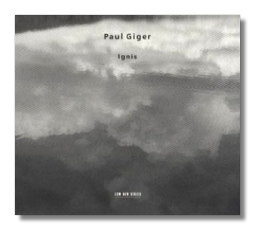
The Internet's Premier Classical Music Source
Related Links
- Latest Reviews
- More Reviews
-
By Composer
-
Collections
DVD & Blu-ray
Books
Concert Reviews
Articles/Interviews
Software
Audio
Search Amazon
Recommended Links
Site News
 CD Review
CD Review
Paul Giger

Ignis
Paul Giger, violin & violino d'amore
Marius Ungureanu, viola
Beat Schneider, cello
Estonian Philharmonic Chamber Choir/Tõnu Kaljuste
ECM New Series 1681 (465648-2) DDD 72:44
Paul Giger, born in Switzerland in 1952, has not been content to remain in the competitive yet artistically safe world that most classical violinists inhabit. Although he has been a leading member of traditional ensembles, he has made the greatest artistic impact as a musician who plays unusual material in uncharacteristic places with unexpected people. As a young man, he wandered through Asia; on an earlier ECM New Series CD (Chartres, ECM New Series 1386 837752-2), he wandered through a cathedral, playing as he went.
This new CD was recorded in a church in the Estonian city of Tallinn. The project came about when Giger's growing interest in writing for the human voice was nurtured by ECM's Manfred Eicher, and also by the same Estonian choir recorded here. Impressed by Giger's solo performances in this church, members of the choir asked him to join them in a new project. The sessions came together in 1998, after correspondence between Giger and Kaljuste.
Of the five works on this CD, only Karma Shadub (Tibetan for "Dancing Star") contains material written entirely by Giger; a non-vocal version of this work appeared on an earlier Giger CD (Alpstein, ECM New Series 1426 847 940-2). Tenebrous drones and chanting by the choir's men slowly admit beams of light from the choir's higher voices and from Giger's violin. It is a tour de force of atmospheric writing and of difficult material evocatively sung.
The rest of the works on this CD are derived from materials by older composers. One feels that, given Giger's preference for improvisatory modes of creation, they are always going to be "works in progress," although there's nothing about them that sounds haphazard or unfinished. The title work is based on a hymn by Hildegard von Bingen. Bingen has been embraced in the past decade as a sort of prophetess of New Age sensibilities. O Ignis does nothing to dispel this notion, but it presents it in a more substantive light; the music seldom rises above a piano, but Giger's creative writing for both the choir and his string trio create an unignorably dramatic and modern impression.
Organum and Alleluja are for string trio alone; the former is taken from an anonymous work from the Notre Dame school (circa 1200), and the latter comes from the work of the monk Notker Balbulus, who lived in the Benedictine abbey of St. Gallen in the 10th century. Tropus, for choir and trio, is based on the work of another Benedictine monk, Tuotilo, who lived at about the same time. The open-ended nature of early music perfectly suits Giger's style, which is essentially thoughtful, exploratory, challenging, and mysterious.
This is one of those late-evening CDs that can create an ineffable impact on one's tired spirit. It relaxes the body, but it's too intellectually stimulating to be taken like a mere tranquilizer. Giger and colleagues, true to the ECM tradition, act as spiritual liaisons between centuries by rethinking old music in modern terms. Ignis burns with a quiet flame. Don't expect much help from the booklet notes in interpreting it, though, because there are practically none. (I am indebted to ECM's press kit for much of the information included in this review!)
Copyright © 2001, Raymond Tuttle


















